Census 2011 equality results: analysis, part two
Publication bringing together relevant statistics from the census and other sources to paint a detailed picture of equality in Scotland.
Chapter 2: Gypsy/Travellers
Introduction
This chapter describes the information collected on Gypsy/Travellers in the 2011 Census and compares the results and characteristics of this group to the Scottish population as a whole. The Scottish Government recognises that Gypsy/Travellers are a particularly marginalised and discriminated against group, and it is committed to ensuring equality of opportunity for all of Scotland's Gypsy/Travellers.
Summary of Findings
In 2011, compared to the population in Scotland, Gypsy/Travellers were:
- Much less likely to be economically active;
- Much more likely to have never worked;
- Much more likely to work in elementary occupations;
- More likely to work in the 'Distribution, Hotels and Restaurants' industry;
- More likely to be self-employed;
- Much more likely to be in the lowest social grade;
- Less likely to be full-time students (16-24 years);
- Much more likely to have no qualifications;
- Much less likely to own their home;
- Much more likely to live in a caravan;
- Much more likely to live in overcrowded accommodation;
- More likely to have no central heating;
- Less likely to have access to a car.
Background
In 2011 a 'White: Gypsy/Traveller' response category was added to the Census form for the first time in Scotland. The following analysis covers those who identified their ethnic group as 'White: Gypsy/Traveller' and were resident either on sites or in settled housing on Census day. Just over 4,000 people identified as 'White: Gypsy/Traveller', but this could be an undercount of the true number of Gypsy/Travellers in Scotland. In this paper those who identified as 'White: Gypsy/Traveller' will be referred as Gypsy/Travellers.
Two recent Equal Opportunities Committee enquiries - 'Gypsy/Travellers and Care' and 'Where Gypsy/Travellers Live' - have highlighted the circumstances of Gypsy/Travellers and made recommendations on how their lives could be improved.
List of Sub-chapters
Key Findings:
Gypsy/Travellers were:
- Much less likely to be economically active;
- Much more likely to have never worked;
- Much more likely to work in elementary occupations;
- More likely to work in the 'Distribution, Hotels and Restaurants' industry;
- More likely to be self-employed;
- Much more likely to be in the lowest social grade;
Chart 2.1: Gypsy/Travellers by Economic Activity - all people aged 16 and over, Scotland 2011
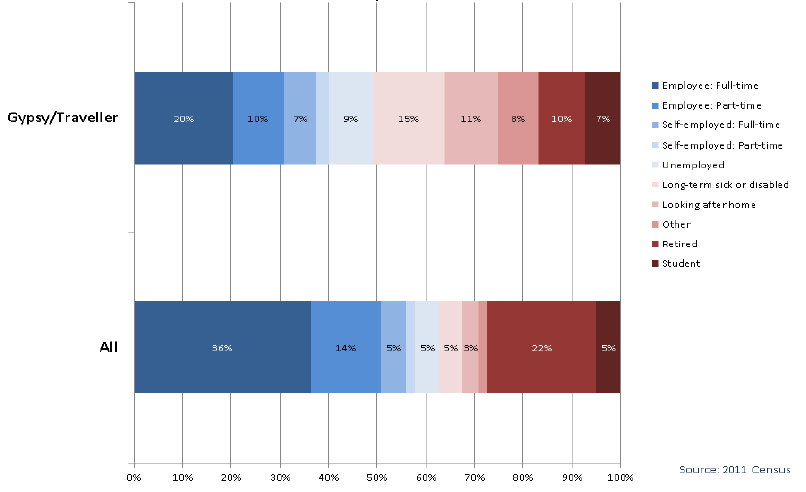
Economic activity [37] relates to whether or not a person aged 16 and over was working or looking for work in the week before the census. Rather than a simple indicator of whether or not someone was currently in employment, it provides a measure of whether or not a person was an active participant in the labour market.
Chart 2.1 shows that Gypsy/Travellers were less likely to be economically active than the population as a whole. Just under half (49 per cent) of Gypsy/Travellers aged 16 and over were economically active compared to almost two thirds (63 per cent) of the population as a whole. Gypsy/Travellers were also much more likely to be long-term sick (15 per cent) or looking after the home (11 per cent).
Only a tenth (10 per cent) of Gypsy/Travellers were retired. This compared to almost a quarter (22 per cent) of the population as a whole. It should be noted that Gypsy/Travellers have a younger age profile.
Chart 2.2: Gypsy/Travellers by Occupational Group - all people aged 16-74 in employment, Scotland 2011
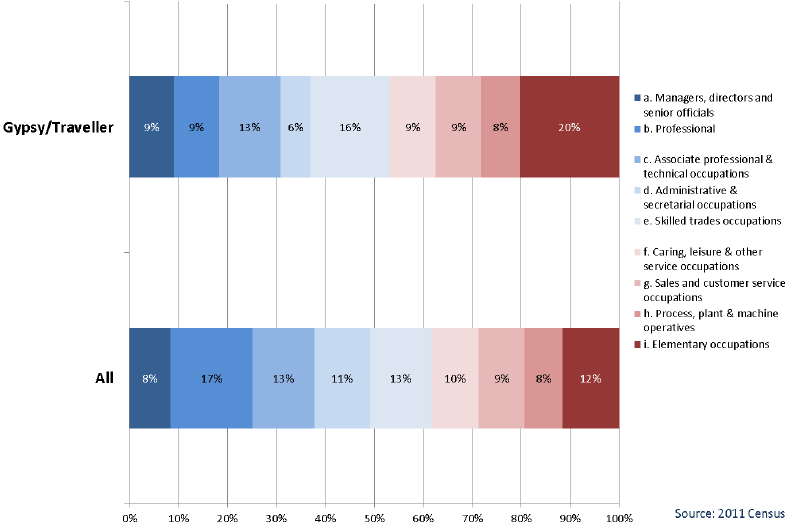
A person's occupation relates to their main job and is derived from either their job title or details of the activities involved in their job. [38]
Chart 2.2 shows that Gypsy/Travellers were much less likely to be in 'Professional' occupations and much more likely to be in 'Elementary occupations' than the population as a whole.
They were also less likely to be employed in 'Administrative and Secretarial' work and more likely to be in 'Skilled Trades Occupations'.
Chart 2.3: Gypsy/Travellers by Industry - all people aged 16-74 in employment, Scotland 2011 [39]
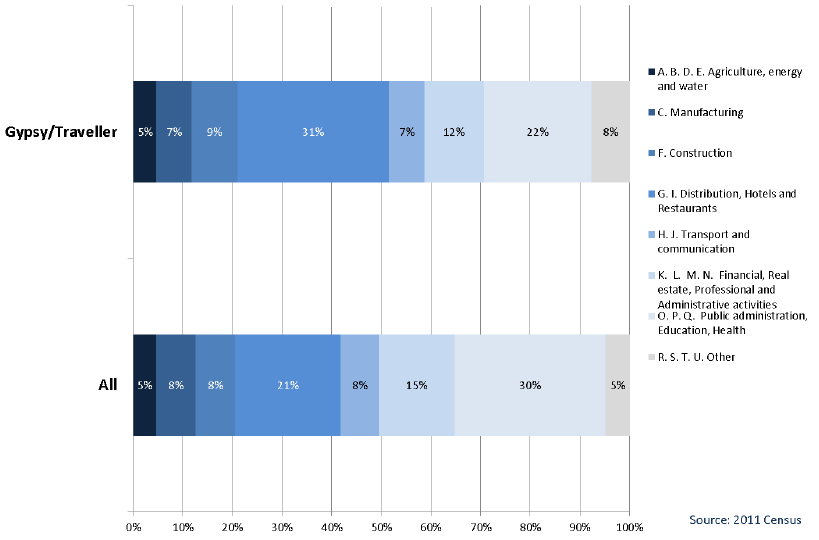
Chart 2.3 shows that Gypsy/Travellers were most likely to be employed in the 'Distribution, Hotels and Restaurants' industry (31 per cent). This was a higher than the proportion for the population as a whole (21 per cent).
Gypsy/Travellers were much less likely to be working in 'Public Administration, Education and Health' (22 per cent) than the general population (30 per cent).
In the other industry groups their representation was fairly similar to the population as a whole.
Chart 2.4: Gypsy/Travellers by NS-SeC - all people aged 16-74, Scotland 2011
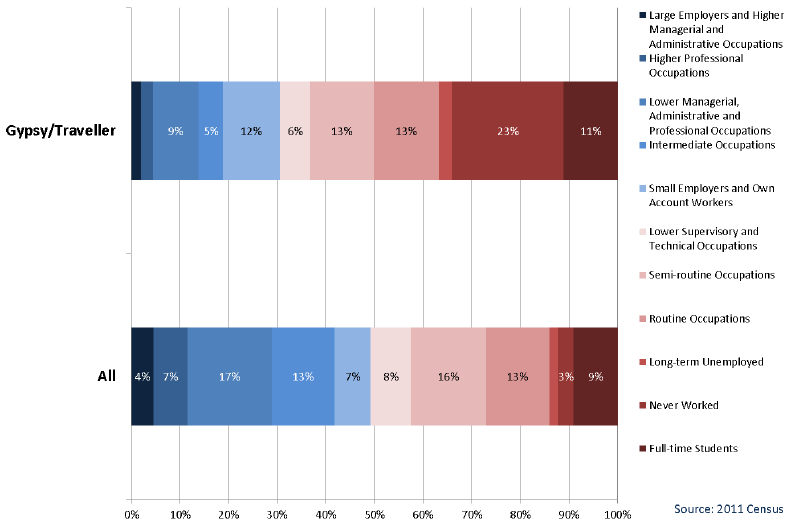
The National Statistics Socio-economic Classification ( NS-SeC) provides an indication of socio-economic position based on occupation. It is an Office for National Statistics ( ONS) standard classification. [40]
Chart 2.4 shows that Gypsy/Travellers were much more likely to have never worked than the population as a whole. Almost a quarter (23 per cent) of Gypsy/Travellers aged 16-74 had never worked compared to only 3 per cent of the population. The younger age profile of the group should be noted when considering these figures.
Gypsy/Travellers were much less likely than the population as a whole to be in Managerial and Professional occupations.
Chart 2.5: Gypsy/Travellers by hours worked - all people aged 16-74 in employment (excluding full-time students), Scotland 2011
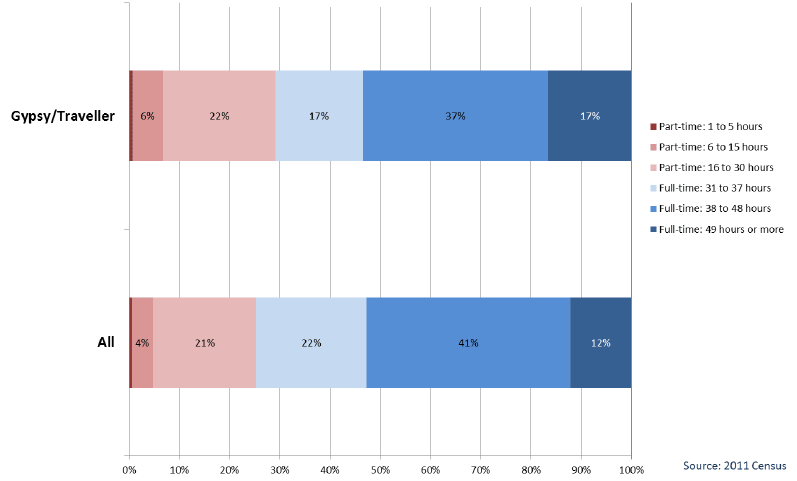
Chart 2.5 shows that a slightly higher proportion of Gypsy/Travellers worked part-time (29 per cent) compared to the population as a whole (25 per cent).
However, those who worked full-time were more likely to work longer hours; 17 per cent worked 49 hours or more per week compared to only 12 per cent of the population as a whole.
Chart 2.6: Gypsy/Travellers by Social Grade - all people in households aged 16-64, Scotland 2011

Chart 2.6 shows that just over a half (51 per cent) of Gypsy/Travellers aged 16-64 were in the lowest social grade [41] : ' DE: Semi-skilled and unskilled manual workers; on state benefit, unemployed, lowest grade workers'. This was almost double the proportion for the population as a whole (26 per cent).
A much lower proportion of Gypsy/Travellers (7 per cent) were in the highest social grade ' AB: Higher and Intermediate Managerial/Administrative/Professional', compared to a fifth (19 per cent) of the population as a whole.
Key Findings:
Gypsy/Travellers were:
- Less likely to be full-time students (16-24 years);
- Much more likely to have no qualifications.
Chart 2.7: Proportion of Gypsy/Travellers aged 16-24 that are Full-time Students, Scotland 2011
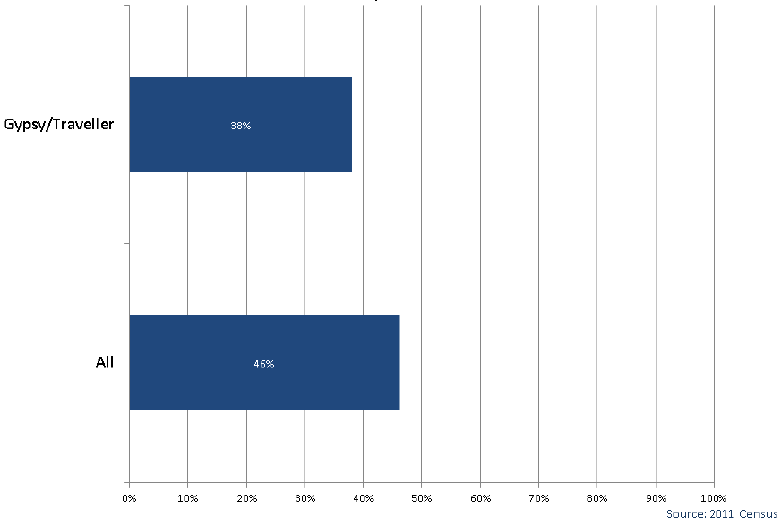
Chart 2.7 shows that Gypsy/Travellers were less likely to be full-time students than the general population aged 16-24. Just under two fifths (38 per cent) of Gypsy/Travellers were full-time students compared to just under half (46 per cent) of the population in this age group.
Chart 2.8: Gypsy/Travellers by Highest Level of Qualification - people aged 16+, Scotland 2011 [42]
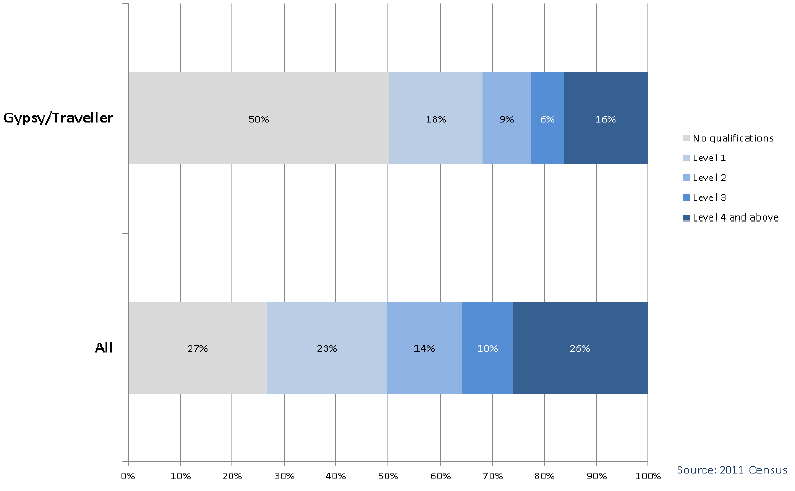
Chart 2.8 shows that half (50 per cent) of Gypsy/Travellers aged 16 and over had no qualifications [43] compared to only around a quarter (27 per cent) of the population as a whole.
Conversely, only 16 per cent of Gypsy/Travellers held 'Level 4 and above' (degree) qualifications compared to 26 per cent of the population as a whole.
Key Findings:
Gypsy/Travellers were:
- Much less likely to own their home;
- Much more likely to live in a caravan;
- Much more likely to live in overcrowded accommodation;
- More likely to have no central heating.
Chart 2.9: Gypsy/Travellers by Tenure - all people in households aged 16+, Scotland 2011 [44]
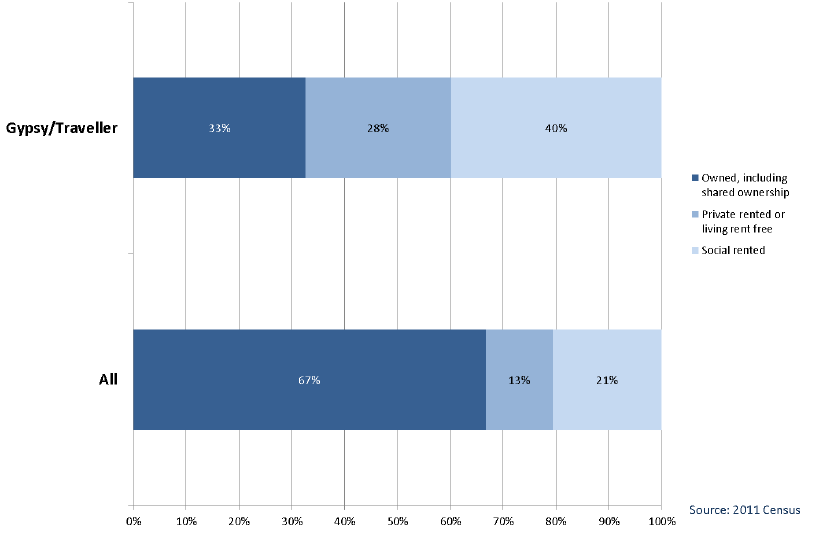
Chart 2.9 shows that Gypsy/Travellers were half as likely to own their homes compared to those in the population as a whole. Only a third (33 per cent) of Gypsy/Travellers owned their home compared to two thirds (67 per cent) of the general population.
Hence Gypsy/Travellers were twice as likely to live in rented accommodation, with two fifths (40 per cent) social renting compared to only one fifth (21 per cent) of the population as a whole.
Chart 2.10 [45] - Gypsy/Traveller households by Accommodation Type, All HRPs, Scotland 2011
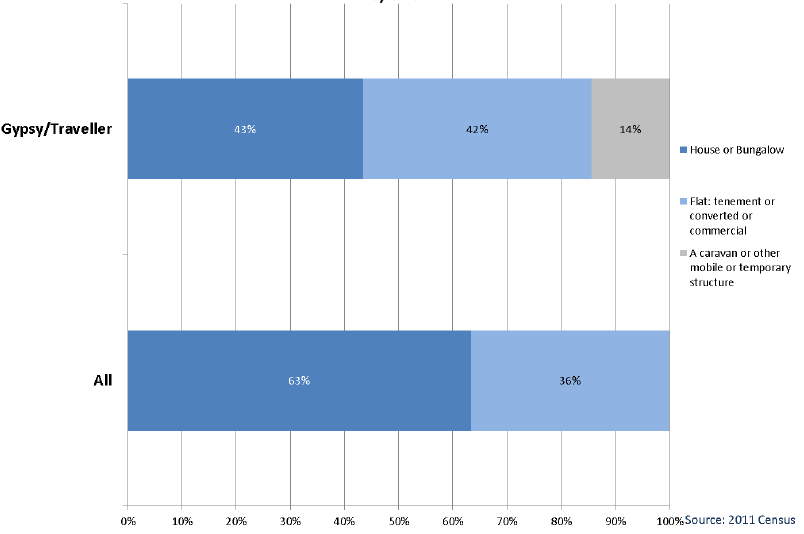
Chart 2.10 shows that a much higher percentage of Gypsy/Traveller households lived in a 'caravan or other mobile or temporary structure' - 14 per cent did so compared to less than one per cent of all households. Conversely, a lower proportion of Gypsy/Traveller households lived in houses or flats. Only 43 per cent of Gypsy/Travellers lived in a house compared to 63 per cent of the population as a whole.
Chart 2.11: Gypsy/Travellers by Landlord Type - all people in rented accommodation aged 16+, Scotland 2011
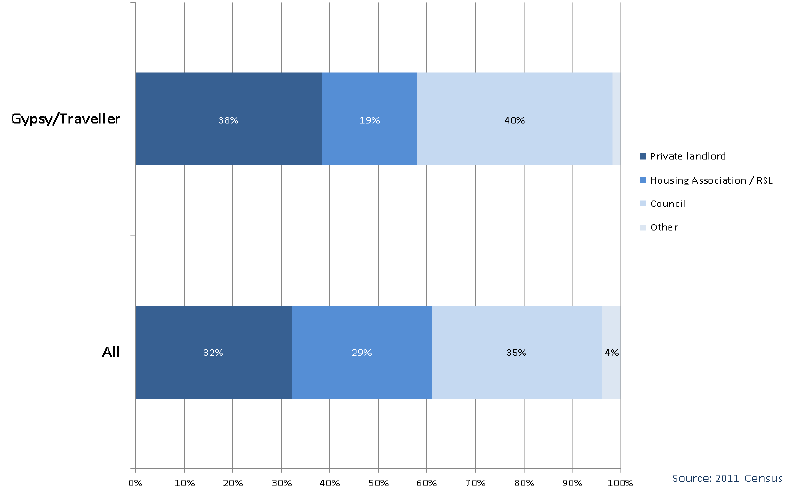
Chart 2.11 shows that compared to the population as a whole a slightly higher proportion of Gypsy/Travellers aged 16 and over (who rented their accommodation) rented from a private landlord and a lower proportion rented from Housing Associations or Registered Social Landlords ( RSL). Around 40 per cent of Gypsy/Travellers who rented their accommodation did so from a council compared to 35 per cent of the population.
Chart 2.12: Gypsy/Traveller households by Occupancy Rating [47] , Scotland 2011
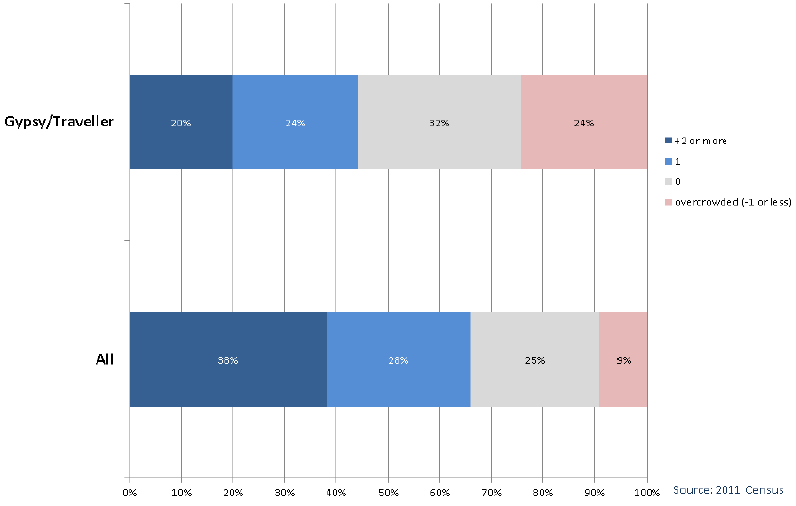
Chart 2.12 shows that Gypsy/Traveller households were more than twice as likely to be overcrowded - a quarter (24 per cent) of Gypsy/Traveller households were overcrowded compared to less than one tenth (9 per cent) of all households.
Gypsy/Travellers households were less likely to be under-occupied ( i.e. have more rooms than the standard requirement) - only 44 per cent were under-occupied compared to two thirds (66 per cent) of all households.
Chart 2.13: Gypsy/Traveller households by type of Central Heating, Scotland 2011
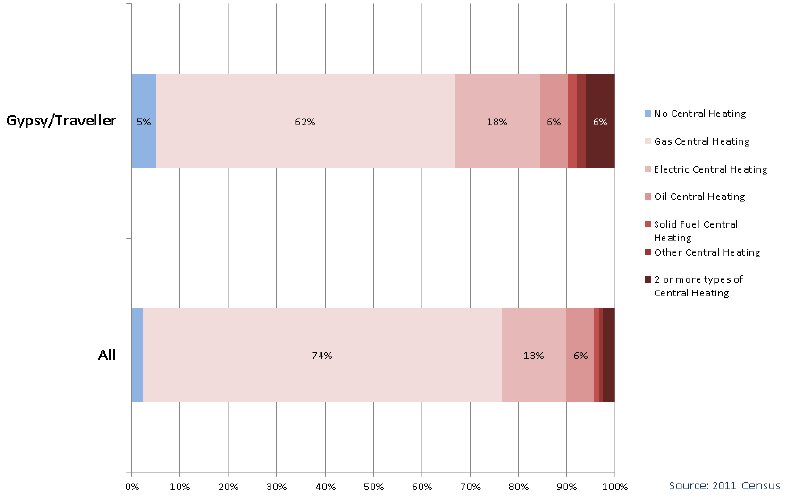
Chart 2.13 shows that Gypsy/Traveller households were more likely to have no central heating (5 per cent) than all households (2 per cent). They were also more likely to have 'Electric Central Heating' and '2 or more types of Central Heating'.
Only 62 per cent of Gypsy/Traveller households had gas central heating compared to 74 per cent of the population.
Key Finding:
- Gypsy/Travellers were less likely to have access to a car.
Chart 2.14: Proportion of Gypsy/Travellers with no Access to a Car or Van by Urban Rural - all people in households aged 16+, Scotland 2011
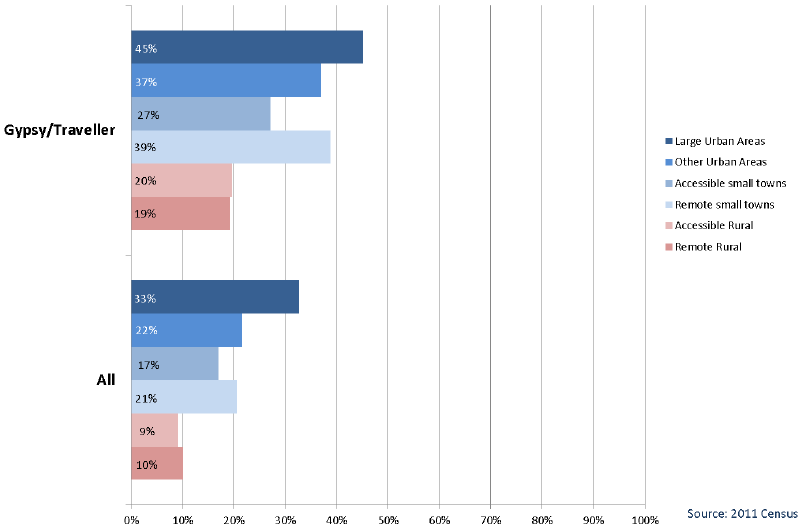
Chart 2.14 shows that a higher proportion of Gypsy/Travellers aged 16 and over were in households with no access to a car or van compared to the population as a whole.
In rural areas a fifth (20 per cent) of Gypsy/Travellers had no access to a car or van compared to only a tenth (10 per cent) of the population as a whole. In small towns, a third of Gypsy/Travellers had no access to a car or van compared to 18 per cent of the population as a whole; in urban areas, two fifths (41 per cent) of Gypsy/Travellers had no car or van access compared to 28 per cent of the population as a whole.
Chart 2.15: Gypsy/Travellers by Method of Travel to Work - all people aged 16-74 in employment (excluding Full-Time students), Scotland 2011
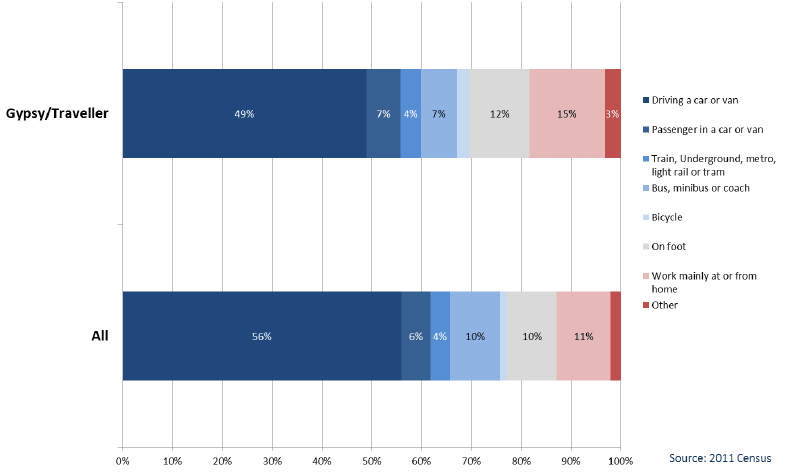
Chart 2.15 shows that just under half (49 per cent) of Gypsy/Travellers drove to work compared to 56 per cent of the population as a whole. A slightly higher proportion of Gypsy/Travellers worked mainly at or from home (15 per cent compared to 11 per cent of the population as a whole).
Chart 2.16: Gypsy/Travellers by Method of Travel to Study - all people aged 4+ studying the week before the Census, Scotland 2011
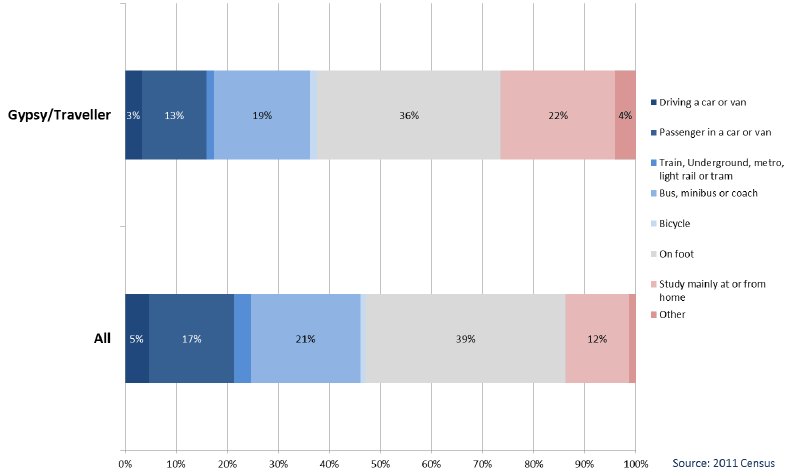
Chart 2.16 shows that Gypsy/Travellers were less likely to travel to their place of study [48] by car and more likely to study at home than the general population. [49] Almost a quarter (22 per cent) of Gypsy/Travellers studied at home compared to an eighth (12 per cent) of people in the population.
Chart 2.17: Gypsy/Travellers by Distance Travelled to Work - all people aged 16-74 in employment (excluding Full-Time students), Scotland 2011
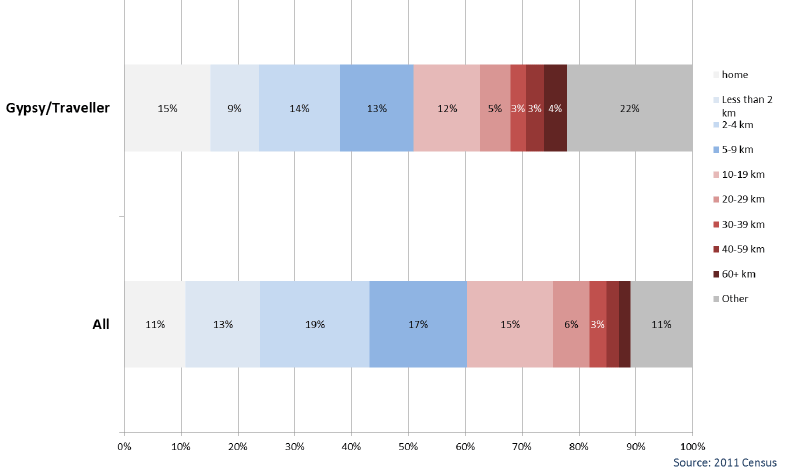
Chart 2.17 shows that Gypsy/Travellers were much more likely to have recorded their distance travelled to work in the 'Other' category, which included those 'No fixed place [of work]', 'Offshore' or 'Outside of the UK'. Over a fifth (22 per cent) of Gypsy/Travellers were in this category compared to just over a tenth (11 per cent) of the population as a whole.
Chart 2.18: Gypsy/Travellers by Distance Travelled to Study - all people aged 4+ studying the week before the Census, Scotland 2011
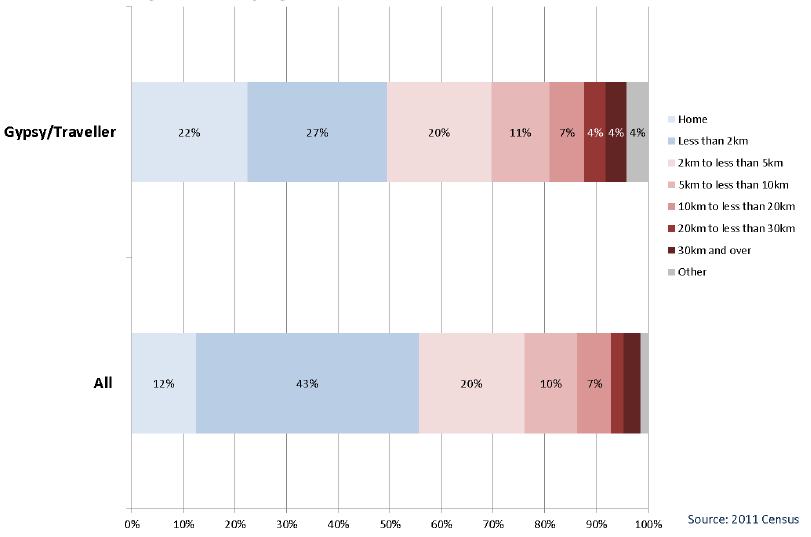
Chart 2.18 shows that Gypsy/Travellers were much more likely to study [50] at home [51] and less likely to travel short distances to their place of study. Only a quarter (27 per cent) travelled less than 2km to their place of study compared to 43 per cent of the population as a whole.
Contact
Email: Poppy Wilson
Phone: 0300 244 4000 – Central Enquiry Unit
The Scottish Government
St Andrew's House
Regent Road
Edinburgh
EH1 3DG
There is a problem
Thanks for your feedback